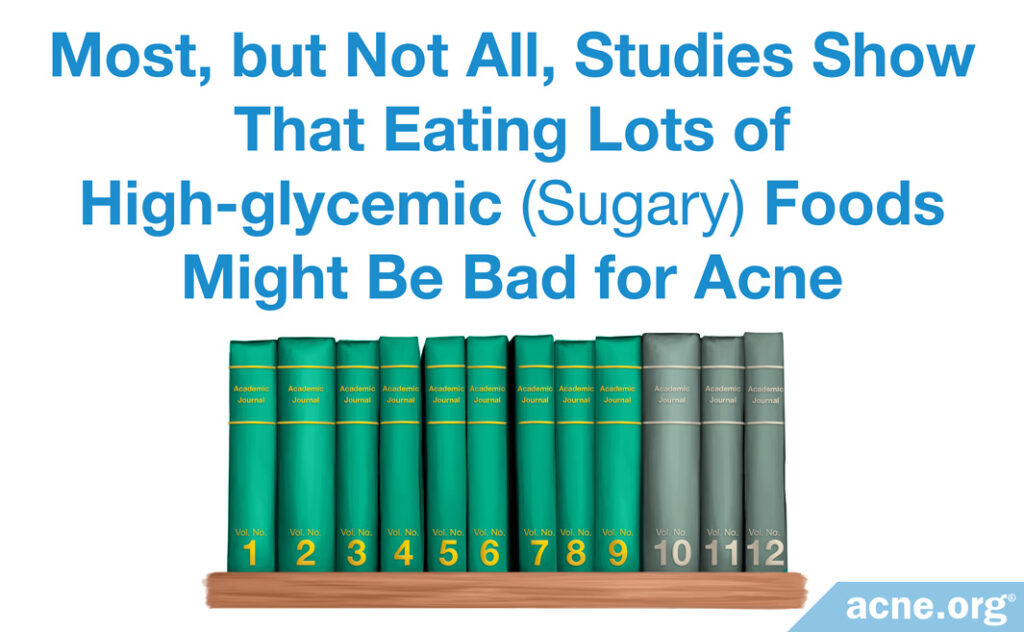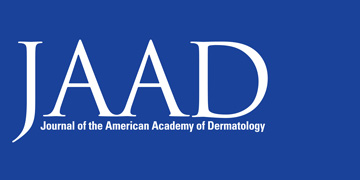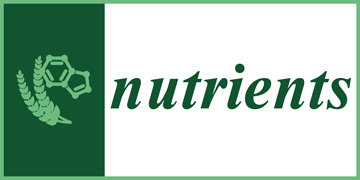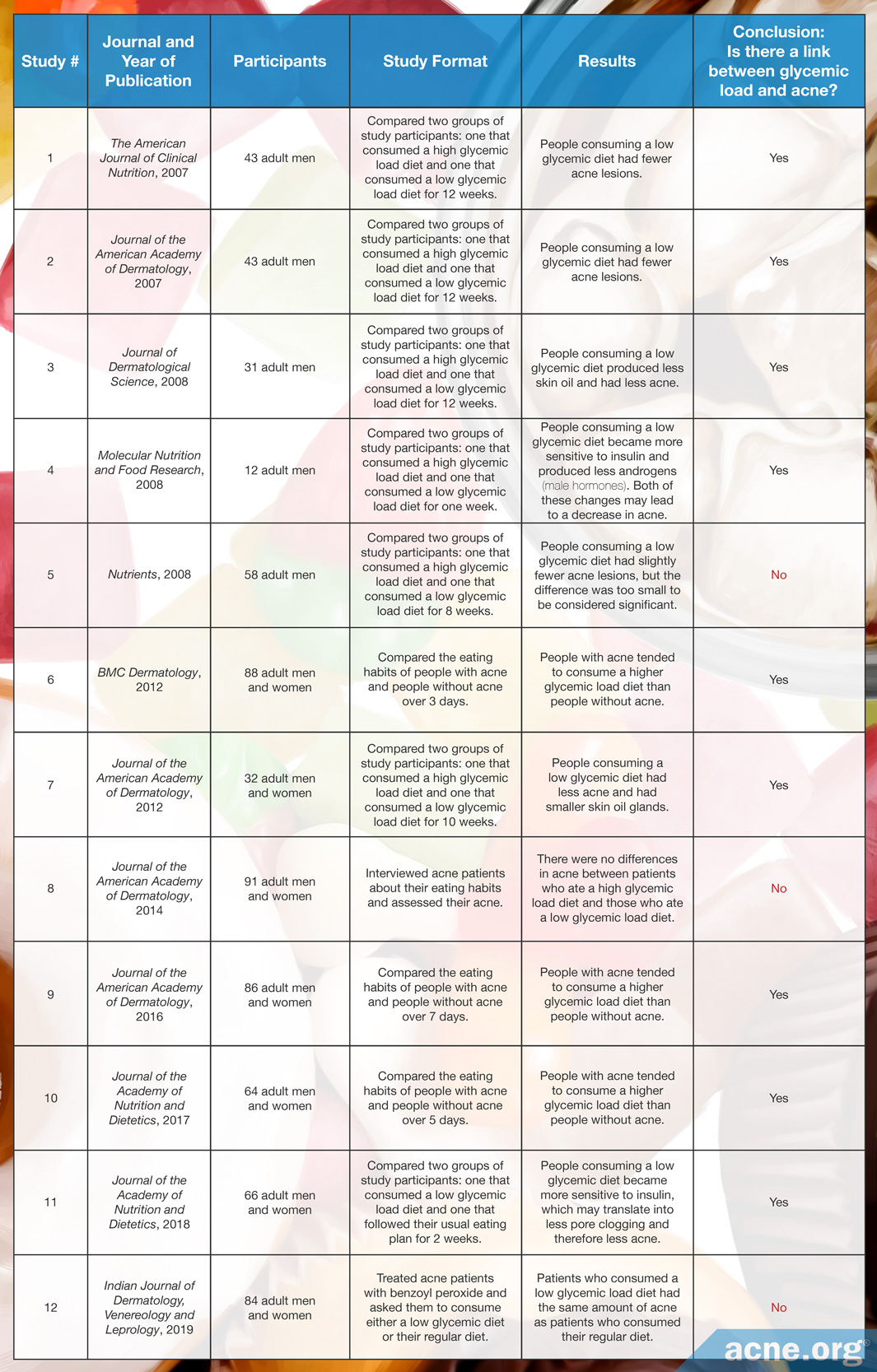Sugary Food and Drinks May Not Be Ideal for Acne, but We Need More Evidence to Know for Sure

The Essential Info
Mounting evidence points towards the possibility that sugary food and drinks may not be ideal when it comes to acne because of their ability to create a sudden increase in blood sugar levels, known as a blood sugar spike.
A blood sugar spike may lead to a cascade of hormones that goes something like this:
- Eating sugary foods and/or drinks leads to a blood sugar spike
- The blood sugar spike leads to an increase in insulin
- An increase in insulin leads to an increase in androgens (male hormones that are present in both males and females)
- An increase in androgens may lead to more acne
However, the evidence is still somewhat contradictory, so we can’t say for sure yet if this is definitely the case.
The Bottom Line: As with most things in life, it likely comes down to moderation. For acne-prone individuals, it is probably fine to occasionally consume a sugary food or drink. But, it is probably not the best idea to make sugary food and drinks a frequent indulgence.

The Science
- As Studies Mount, It Appears High Glycemic Foods Might Lead to More Acne
- Eating Lots of Sugary Food is Probably Not Ideal for Acne-Prone Skin
Some foods, like candy and soda, contain lots of added sugar. Emerging research suggests high-sugar foods like these may not be ideal for acne. This is because of a concept known as the glycemic load.
Glycemic load
The glycemic load is a measurement scientists use to determine whether a food will cause an increase in the amount of sugar in your blood.
Using the glycemic load, foods are mainly classified into either high glycemic load foods or low glycemic load foods:
- High glycemic load foods: Examples include candy and sugary drinks, but also processed foods like white bread, white rice, crackers, pretzels, etc. High glycemic load foods cause a large and sudden increase in the amount of sugar in your blood.
- Low glycemic load foods: Examples include whole foods like vegetables, fish/meats, eggs, oils, etc. Low glycemic load foods do not cause a large or sudden increase in the amount of sugar in your blood.
Glycemic load also takes into consideration how much of a particular food you eat. For example, you’ll get a much bigger spike in blood sugar if you eat an entire candy bar than you would if you have only one bite.
Why would the glycemic load matter for acne?
When the body detects an increase in blood sugar, it reacts by releasing a corresponding amount of insulin. Simply put, insulin is a “master hormone,” which means an increase in insulin can lead to an increase in other hormones.
In the case of acne, the concern is that an increase in insulin will lead to an increase in androgens (male hormones that are present in both males and females). It is well known that higher androgen levels in both males and females leads to more acne.
It all sounds simple enough right? Well, not so fast. Studying the effects of diet on disease is notoriously difficult, and while most studies to date point toward a connection between a high glycemic load diet and acne, we’ll need more studies before we can confidently state that there is a strong connection.
As Studies Mount, It Appears High Glycemic Foods Might Lead to More Acne

Scientists have performed a dozen studies to examine whether a high glycemic diet would lead to acne.1-12 Most of these studies have found that people who eat a lot of high glycemic load foods develop more acne.
However, each of these studies only examined a small number of people, and this is not a reliable way to collect data. So, more research is needed with a larger number of people to truly determine if a large amount of sugar in the food and drinks we consume can cause acne. But from what we’re seeing so far, there appears to potentially be a connection.13
To learn more about these studies, click below.
Based on the results of these small studies, experts cautiously recommend that people with acne may want to try a low glycemic load diet in addition to standard acne treatments.

A 2019 article in the Journal of the American Academy of Dermatology gave the following advice for doctors: “Additional evidence is needed regarding the impact of [low glycemic load diet] on acne; however, given the low risk and potential health benefits of [low glycemic load diet]…we feel the practitioner should consider recommending [low glycemic load diets] as a helpful adjuvant for the treatment of acne.”14
Eating Lots of Sugary Food is Probably Not Ideal for Acne-Prone Skin
We have seen that most studies have found an association between high-sugar diets and acne, and established science shows us that eating sugary foods causes an increase in blood sugar levels, which can lead to other hormone changes in the body. So putting all of this together, the picture starts to come into focus that eating lots of sugary foods (or high glycemic load foods) is probably less than ideal if you are prone to acne.
However, as with most things in life, it most likely comes down to moderation. Remember, the glycemic load takes into consideration how much of a food you eat. So, if you eat a small amount of a sugary food or drink a small sugary drink on occasion, it probably will not have much effect on your acne. But, if you are acne-prone, it is probably not a great idea to make sugary food and drinks a big part of your diet.
Encouragingly, recent research suggests that people with acne are starting to become more aware of the possible impact of sugary foods on acne. However, awareness is half the battle—the other half is making adjustments to your diet, which can be easier said than done.

A study published in the journal Nutrients in 2022 found that among 1,329 teens and adults with acne, over half consumed high glycemic load foods several times a week. The study authors wrote, “In the present study, the [participants] were aware that foods with a high glycemic index can exert a negative effect on skin condition and aggravate acne, but very few participants limited their intake of such products.”15
The tips below can help you move from awareness to action.
Tips for how to moderate your sugar intake
- Don’t drink soda! This is an easy one. Soda contains lots of sugar, and cutting it out of your diet is a great way to reduce your sugar intake.
- Moderate your intake of candy or anything with lots of sugar. Foods that contain high amounts of sugar like candy, cakes, pies, doughnuts, sweetened yogurt, fruit juices, sports drinks, and sweetened coffee-based drinks, are probably fine in moderation and on occasion, but don’t gorge yourself on them, and don’t eat them frequently.
- Moderate your intake of other high glycemic load foods. Pay attention to foods that don’t contain a lot of sugar, but still have a high glycemic load, like white bread, white rice, pretzels, crackers, chips, and rice cakes. As with foods that contain lots of sugar, these are probably fine in moderation, but try not to make them a major part of your diet.
- Do your best to move your diet toward “whole foods.” An easy way to eat lower glycemic is to eat real, whole foods, like vegetables, fish/meat, oils, eggs, nuts, seeds, whole fruits, and whole grains.
- Drink a little apple cider vinegar during or immediately after you eat a high glycemic load meal. This is a fun way to reduce your blood sugar spike that you can do up to once per day (not more often). Pour 1-2 tablespoons (not more) of apple cider vinegar (or any other vinegar, but apple cider tastes better) in a cup and dilute it with 8 ounces of water (make sure you dilute it–don’t drink it on its own) and drink it. This will tamp down the blood sugar spike, and it actually tastes kinda refreshing.
- Only get “carried away” with this if it feels positive. This is a tip directly from me to you. When I first read that sugar might lead to acne when I was in college, I became overly focused on completely eliminating sugar from my diet. Eliminating sugar did not lead to clear skin for me, but did lead to stress, which can also aggravate acne. What I usually tell people is if you are invited to a friend’s birthday party, have a piece of cake! Just go back to eating whole foods afterward, and don’t make high-sugar or high glycemic load foods a staple of your diet.
References
- Smith, R. N., Mann, N. J., Braue, A., Makelainen, H. & Varigos, G. A. A low-glycemic-load diet improves symptoms in acne vulgaris patients: A randomized controlled trial. American Journal of Clinical Nutrition 86, 107-115 (2007). https://www.ncbi.nlm.nih.gov/pubmed/17616769
- Smith, R. N., Mann, N. J., Braue, A., Makelainen, H. & Varigos, G. A. A low-glycemic-load-diet versus a conventional, high-glycemic-load diet on biochemical parameters associated with acne vulgaris: A randomized investigator-masked, controlled trial. Journal of American Academy of Dermatology 57, 247-256 (2007). https://www.ncbi.nlm.nih.gov/pubmed/17448569
- Smith, R. N., Braue, A., Varigos, G. & Mann, N. J. The effect of a low glycemic load diet on acne vulgaris and the fatty acid composition of skin surface triglycerides. Journal of Dermatological Science 50, 41-52 (2008). https://www.ncbi.nlm.nih.gov/pubmed/18178063
- Smith, R. N., Mann, N., Makelainen, H., Roper, J., Braue, A. & Varigos, G. A pilot study to determine the short-term effects of a low glycemic load diet on hormonal markers of acne: A nonrandomized, parallel, controlled feeding trial. Molecular Nutrition Food Research 52, 718-726 (2008). https://www.ncbi.nlm.nih.gov/pubmed/18496812
- Reynolds, R. C., Lee, S., Choi, J. Y. et al. Effect of the glycemic index of carbohydrates on acne vulgaris. Nutrients 2, 1060-1072 (2010). https://www.ncbi.nlm.nih.gov/pubmed/22253996
- Ismail, N. H., Manaf, Z. A. & Azizan, N. Z. High glycemic load diet, milk and ice cream consumption are related to acne vulgaris in Malaysian young adults: a case control study. BMC Dermatol. 12, 13 (2012). https://www.ncbi.nlm.nih.gov/pubmed/22898209
- Zaenglein, A. L. et al. Guidelines of care for the management of acne vulgaris. Journal of the American Academy of Dermatology 74, 945-973 (2016). https://www.ncbi.nlm.nih.gov/pubmed/26897386
- Bronsnick, T., Murzaku, E. C. & Rao, B. K. Diet in dermatology: Part I. Atopic dermatitis, acne, and nonmelanoma skin cancer. Journal of the American Academy of Dermatology 71, 1039 (2014). https://www.ncbi.nlm.nih.gov/pubmed/25454036
- Çerman, A. A., Aktaş, E., Altunay, İ. K., Arıcı, J. E., Tulunay, A. & Ozturk, F. Y. Dietary glycemic factors, insulin resistance, and adiponectin levels in acne vulgaris. J. Am. Acad. Dermatol. 75, 155-162 (2016). https://www.ncbi.nlm.nih.gov/pubmed/27061046
- Burris, J., Rietkerk, W., Shikany, J. M. & Woolf, K. Differences in dietary glycemic load and hormones in New York City adults with no and moderate/severe acne. J. Acad. Nutr Diet. 117, 1375-1383 (2017). https://www.ncbi.nlm.nih.gov/pubmed/28606553
- Burris, J., Shikany, J. M., Rietkerk, W. & Woolf, K. A Low glycemic index and glycemic load diet decreases Insulin-like Growth Factor-1 among adults with moderate and severe acne: A short-duration, 2-week randomized controlled trial. J. Acad. Nutr. Diet. 118, 1874-1885 (2018). https://pubmed.ncbi.nlm.nih.gov/29691143/
- Pavithra, G., Upadya, G. M. & Rukmini, M. S. A randomized controlled trial of topical benzoyl peroxide 2.5% gel with a low glycemic load diet versus topical benzoyl peroxide 2.5% gel with a normal diet in acne (grades 1-3). Indian J. Dermatol. Venereol. Leprol. 85, 486-490 (2019). https://www.ncbi.nlm.nih.gov/pubmed/30264745
- Cao, H., Yang, G., Wang, Y. et al. Complementary therapies for acne vulgaris. Cochrane Database Syst Rev. 1, CD009436 (2015). https://pubmed.ncbi.nlm.nih.gov/25597924/
- Barbieri, J. S., Spaccarelli, N., Margolis, D. J. & James, W. D. Approaches to limit systemic antibiotic use in acne: Systemic alternatives, emerging topical therapies, dietary modification, and laser and light-based treatments. J Am Acad Dermatol. 80, 538-549 (2019). https://pubmed.ncbi.nlm.nih.gov/30296534/
- Kostecka, M., Kostecka, J., Szwed-Gułaga, O., Jackowska, I. & Kostecka-Jarecka, J. The impact of common acne on the well-being of young people aged 15-35 years and the influence of nutrition knowledge and diet on acne development. Nutrients 14, 5293-5306 (2022). https://pubmed.ncbi.nlm.nih.gov/36558452/
The post Do Sugary Foods and Drinks Cause Acne? appeared first on Acne.org.

